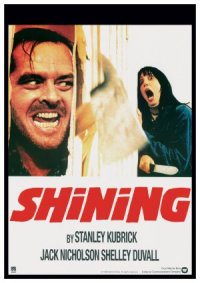 |
| Fig. 1 |
Early on, the film introduces the basic elements of the story - a struggling writer, Jack Torrance (Jack Nicholson), agrees to take a job as a live-in caretaker for the winter at an isolated hotel with a dark history - and then proceeds to chart his how during the months cut off from the world he descends into a homicidal mania. Director Stanley Kubric spends the first half of the film carefully setting up and then undermining the cliches of the horror genre; tense, ominous music precedes the end of every scene until even the appearance of the word "Tuesday" causes the audience to jump. Jack's son Danny (Danny Lloyd) croaks Cassandra-like of future horrors in a way made all the more creepy by his parent's unquestioning acceptance of his behaviour (Maslin, 1980)
Kubric makes extensive use of the then newly invented "Steadicam" to give the film a disembodied feel, the camera gliding around the too-perfect geometries of the Overlook hotel with a smoothness that no human could ever manage. At the same time, the contrast between the cold green service areas and the sickly yellow colour scheme of the main hotel is used again and again as the family go about their everyday life, most notably in an iconic scene where Danny rides his tricycle in around the hotel, the rumbling of the wheels interspersed with eerie silence whenever he crosses a carpeted area.
 |
| Fig. 2 |
 |
| Fig. 3 |
The final word must go to Ian Nathan of Empire magazine; "It's a question the whole film is posing: does the potential for evil reside in all men, just waiting to come to life? The final shot of Torrance trapped inside a photograph of the ballroom in 1921 hints at his destiny: he has become one with The Overlook — as he always was (death, you see, is never the end). The point, though, for the infuriatingly brilliant Kubrick was to always keep the answers out of reach. Indeed, he had a mantra he exhorted to all concerned (actors and journalists alike), it's a quote from H.P. Lovecraft: "In all things that are mysterious — never explain." (Nathan, 1980)
List of Illustrations
Figure 1. Warner Bros. Pictures (Org) (1980) The Shining Theatrical Poster [Digital Image] At: http://www.movieposterdb.com/movie/0081505/The-Shining.html (Accessed on 20/01/2011)
Figure 2. Warner Bros. Pictures (Org) (1980) The Shining [Film Still] At: http://www.hundland.org/hd/s/theshining4.jpg (Accessed on 20/01/2011)
Figure 3. Warner Bros. Pictures (Org) (1980) The Shining [Film Still] At:http://www.imdb.com/media/rm2380891904/tt0081505 (Accessed on 20/01/2011)
Bibliography
Ebert, Roger (2006) The Shining 1980 In: rogerebert.com [Online] At: http://rogerebert.suntimes.com/apps/pbcs.dll/article?AID=/20060618/REVIEWS08/606180302 (Accessed on 20/01/2011)
Masline, Janet (1980) Flaws don't dim "The Shining" In: The New York Times [Online] At: http://www.nytimes.com/library/film/060880kubrick-shining.html (Accessed on 20/01/2011)
Nathan, Ian (1980) Empire Essay: The Shining In: Empire Magazine [Online] At: http://www.empireonline.com/reviews/reviewcomplete.asp?FID=132700 (Accessed on 20/01/2011)

great review, Dan. You write very engagingly - it's a talent, so look for opportunities to use it.
ReplyDelete